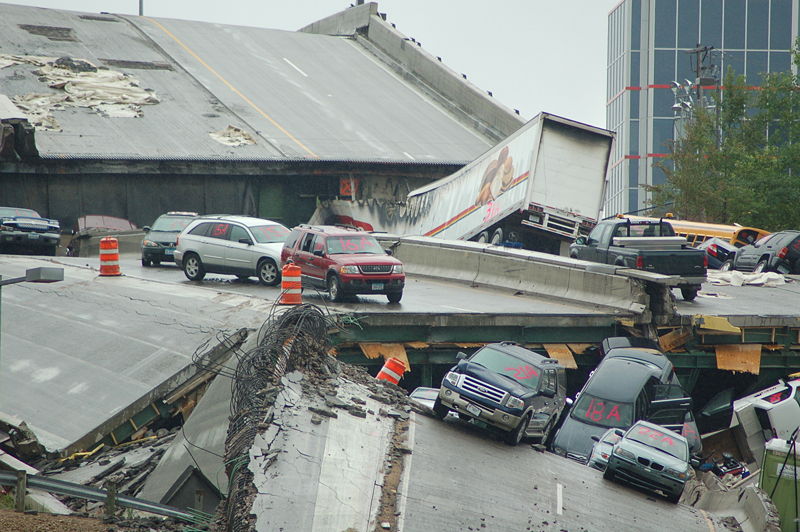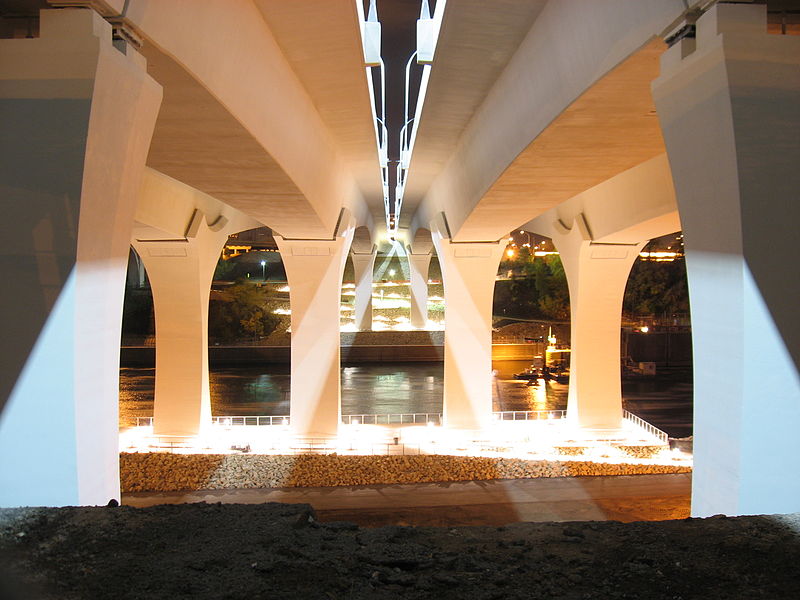On August 1, 2007, the I-35W Mississippi River Bridge in Minneapolis, MN failed in one of the most dramatic displays of faulty engineering in recent memory. The bridge experienced a catastrophic collapse that killed 13 and injured 145. In addition, the bridge collapse closed a major vehicular link to the city of Minneapolis for over a year, causing major impacts on transportation in the area.
Background
Built in 1964, the I-35W Bridge was a key portion of the Twin Cities freeway system. The bridge used steel trusses for support, and spanned the entire width of the river in one arch to allow the river channel to remain navigable for boats passing below. The bridge frequently received low ratings following inspections and showed increasing signs of structural instability as it aged. The bridge also suffered from frequent buildup of black ice, resulting in many accidents in the winter months. In early 2000, the bridge was fitted with a black ice prevention system that sprayed a liquid agent onto the road surface, preventing these accidents. It has been argued that this system may have contributed to the bridge’s failure.
Collapse

A number of factors contributed to the collapse of the bridge. Primarily, it was found that undersized gusset plates used in construction became critically overloaded as the bridge was resurfaced and the dead load increased. Additionally, over 500,000 pounds of construction material and equipment was present on the bridge during its collapse, which exacerbated problems with the overloaded gusset plates. A massive effort was required to rescue the victims of the collapse while still maintaining the integrity of the site so that the cause of collapse could be determined. It took over a year of analysis and testing for the final cause of collapse to be determined.
Effect on Transportation
The collapse of the bridge had massive effect on transportation in the area. While the bridge carried only vehicular traffic, it also impacted or halted river, rail, bicycle, pedestrian, and air travel in the area. The river was closed to navigation in the area as the debris filled water was impassible for boats. A portion of the bridge fell onto a rail spur adjacent to the river, closing rail access to that line. The Grand Rounds National Scenic Byway bike path was impacted by the collapse, and the FAA created a 3 mile radius of restricted airspace around the accident site. Additionally, a secondary bridge located just a block downstream was closed to all non-emergency traffic for a month following the incident. The ripple effect that the failure of one element can have on a larger transportation system is incredible.
Although a replacement bridge was built in just over a year, massive changes were necessary to supplement the missing bridge while repairs were underway. Trunk Highway 280, a nearby road, was temporarily converted to a freeway by closing all cross roads along its length. Other local highways were repainted to increase the number of lanes and modified to remove choke points. Extra busses were added and commuters were encouraged to take public transportation or seek alternate routes. Thankfully, it took only a year to construct the replacement bridge, allowing for restoration of the existing transportation system and a return to normal for drivers. The effects of the collapse will not soon be forgotten however. The I-35W Bridge collapse is a great look at our reliance on transportation systems and the consequences of their failure.

Sources:
- http://en.wikipedia.org/wiki/I-35W_Mississippi_River_bridge
Images:
- http://en.wikipedia.org/wiki/File:I35W_Collapse_-_Day_4_-_Operations_%26_Scene_(95).jpg
- http://en.wikipedia.org/wiki/File:Under_the_35W_Bridge.jpg
